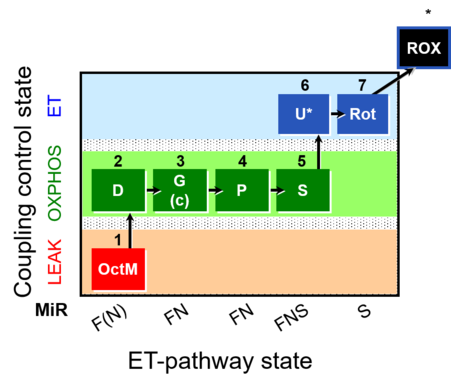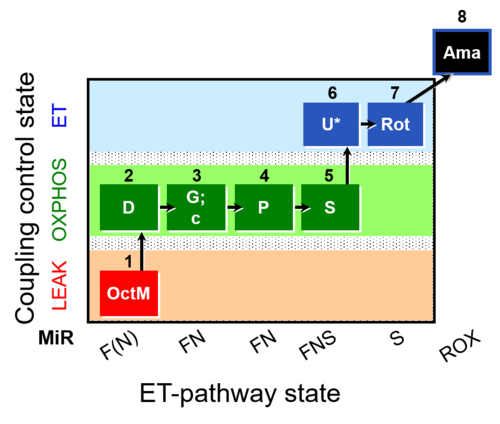Difference between revisions of "SUIT-015"
From Bioblast
Beno Marija (talk | contribs) |
|||
| (42 intermediate revisions by 9 users not shown) | |||
| Line 1: | Line 1: | ||
{{MitoPedia | {{MitoPedia | ||
|abbr= | |abbr=F+G+P+S_OXPHOS+Rot_ET | ||
|description=[[File:1OctM;2D;3G;4P;5S;6U;7Rot-.png| | |description=[[File:1OctM;2D;3G;4P;5S;6U;7Rot-.png|451px]] | ||
|info='''A | |info='''A: [[Fatty_acid_oxidation_pathway_control_state|F-pathway]] in [[LEAK respiration#The_LEAK_state |LEAK state]] and [[Oxidative phosphorylation|OXPHOS state]]''' | ||
}} | }} | ||
::: '''[[SUIT protocol pattern]]:''' 1OctM;2D;3G;4P;5S;6U:7Rot- | |||
SUIT-015 gives information on [[Fatty_acid_oxidation_pathway_control_state|F-pathway]] in [[LEAK respiration#The_LEAK_state |LEAK state]] and [[Oxidative phosphorylation|OXPHOS state]] avoiding FAO overestimation in the presence of [[Anaplerosis|anaplerotic]] pathways. In addition, the pathway control of [[FN]] and [[FNS]] in [[Oxidative phosphorylation|OXPHOS state]] and of [[FNS]] and [[S]] in [[ET capacity| ET state]] can be evaluated. SUIT-015 can be extended with the CIV assay module. | |||
::: '''[[SUIT protocol pattern]]:''' | |||
__TOC__ | __TOC__ | ||
== | Communicated by [[Doerrier C]], [[Huete-Ortega M]], [[Gnaiger E]] (last update 2019-06-05) | ||
| | == Specific SUIT protocols == | ||
[[File:1OctM;2D;3G;3c;4P;5S;6U;7Rot;8Ama.png|500px]][[File:D042 Traces.png|800px]] | |||
* [[SUIT-015 O2 pti D043]] for permeabilized tissue | |||
{{Template: | {{Template:SUIT-015}} | ||
== Strengths and limitations == | == Strengths and limitations == | ||
| Line 31: | Line 22: | ||
:::+ The protocol provides information on FAO capacity in the absence of other, potentially interfering pathways, both in the LEAK state and in OXPHOS. | :::+ The protocol provides information on FAO capacity in the absence of other, potentially interfering pathways, both in the LEAK state and in OXPHOS. | ||
:::+ FNS OXPHOS capacity comprises the most important pathways in many cell types and thus provides a physiologically relevant estimate of maximum mitochondrial respiratory capacity. | :::+ FNS OXPHOS capacity comprises the most important pathways in many cell types and thus provides a physiologically relevant estimate of maximum mitochondrial respiratory capacity. | ||
:::+ FNS ET capacity is a good estimate of | :::+ FNS ET capacity is a good estimate of overall ET capacity in many cell types. | ||
:::+ The presence of PMG and S establishes fully operative TCA cycle activity | :::+ The presence of PMG and S establishes a fully operative TCA cycle activity. | ||
:::+ Reasonable duration of the experiment. | :::+ Reasonable duration of the experiment. | ||
:::- Application of the cytochrome ''c'' test after 3G in the protocol does not ensure comparability of all states in case of any effect of ''c''. However, it allows to analyse whether the outer mt-membrane integrity is compromised. | |||
:::- F OXPHOS capacity may be underestimated. In human heart muscle addition of Oct to palmitoylcarnitine (Pal) + malate increased OXPHOS by 26% ( | :::- F OXPHOS capacity may be underestimated. In human heart muscle addition of Oct to palmitoylcarnitine (Pal) + malate increased OXPHOS by 26% (Lemieux et al 2011). | ||
:::- SRot(E) may be underestimated if S is not saturating. | :::- SRot(E) may be underestimated if S is not saturating. | ||
:::- CIV activity is not measured, to save experimental time. | :::- CIV activity is not measured, to save experimental time. | ||
== Compare SUIT protocols == | == Compare SUIT protocols == | ||
::::* [[SUIT-002]] | |||
::::* [[SUIT-019]] | |||
::::* [[SUIT-028]] | |||
== References == | |||
{{#ask:[[Category:Publications]] [[Instrument and method::O2k-Protocol]] [[Additional label::SUIT-015]] | |||
|?Was published in year=Year | |||
|?Has title=Reference | |||
|?Mammal and model=Organism | |||
|?Tissue and cell=Tissue;cell | |||
|format=broadtable | |||
|limit=5000 | |||
|offset=0 | |||
|sort=Was published in year | |||
|order=descending | |||
}} | |||
{{MitoPedia concepts | {{MitoPedia concepts | ||
|mitopedia concept=SUIT protocol, | |mitopedia concept=MiP concept, SUIT protocol, Recommended | ||
}} | |||
{{MitoPedia methods | |||
|mitopedia method=Respirometry | |||
}} | }} | ||
Latest revision as of 15:21, 8 June 2020
Description
Abbreviation: F+G+P+S_OXPHOS+Rot_ET
Reference: A: F-pathway in LEAK state and OXPHOS state
- SUIT protocol pattern: 1OctM;2D;3G;4P;5S;6U:7Rot-
SUIT-015 gives information on F-pathway in LEAK state and OXPHOS state avoiding FAO overestimation in the presence of anaplerotic pathways. In addition, the pathway control of FN and FNS in OXPHOS state and of FNS and S in ET state can be evaluated. SUIT-015 can be extended with the CIV assay module.
Communicated by Doerrier C, Huete-Ortega M, Gnaiger E (last update 2019-06-05)
Specific SUIT protocols
- SUIT-015 O2 pti D043 for permeabilized tissue
Steps and respiratory states
| Step | State | Pathway | Q-junction | Comment - Events (E) and Marks (M) |
|---|---|---|---|---|
| 1OctM | OctML | F(N) | CETF | 1OctM
|
| 2D | OctMP | F(N) | CETF | 1OctM;2D
|
| 3G | OctGMP | FN | CETF&CI | 1OctM;2D;3G
|
| 3c | OctGMcP | FN | CETF&CI | 1OctM;2D;3G;3c
|
| 4P | OctPGMP | FN | CETF&CI | 1OctM;2D;3G;3c;4P
|
| 5S | OctPGMSP | FNS | CETF&CI&II | 1OctM;2D;3G;3c;4P;5S
|
| 6U | OctPGMSE | FNS | CETF&CI&II | 1OctM;2D;3G;3c;4P;5S;6U
|
| 7Rot | SE | S | CII | 1OctM;2D;3G;3c;4P;5S;6U;7Rot
|
| 8Ama | ROX | 1OctM;2D;3G;3c;4P;5S;6U;7Rot;8Ama
|
| Step | Respiratory state | Pathway control | ET-Complex | Comment |
|---|---|---|---|---|
| ## AsTm | AsTmE | CIV | CIV | |
| ## Azd | CHB |
- Bioblast links: SUIT protocols - >>>>>>> - Click on [Expand] or [Collapse] - >>>>>>>
- Coupling control
- Pathway control
- Main fuel substrates
- » Glutamate, G
- » Glycerophosphate, Gp
- » Malate, M
- » Octanoylcarnitine, Oct
- » Pyruvate, P
- » Succinate, S
- Main fuel substrates
- Glossary
Strengths and limitations
- + The protocol provides information on FAO capacity in the absence of other, potentially interfering pathways, both in the LEAK state and in OXPHOS.
- + FNS OXPHOS capacity comprises the most important pathways in many cell types and thus provides a physiologically relevant estimate of maximum mitochondrial respiratory capacity.
- + FNS ET capacity is a good estimate of overall ET capacity in many cell types.
- + The presence of PMG and S establishes a fully operative TCA cycle activity.
- + Reasonable duration of the experiment.
- - Application of the cytochrome c test after 3G in the protocol does not ensure comparability of all states in case of any effect of c. However, it allows to analyse whether the outer mt-membrane integrity is compromised.
- - F OXPHOS capacity may be underestimated. In human heart muscle addition of Oct to palmitoylcarnitine (Pal) + malate increased OXPHOS by 26% (Lemieux et al 2011).
- - SRot(E) may be underestimated if S is not saturating.
- - CIV activity is not measured, to save experimental time.
Compare SUIT protocols
References
MitoPedia concepts: MiP concept, SUIT protocol, Recommended
MitoPedia methods:
Respirometry





